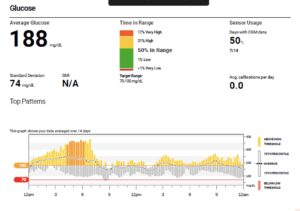
The Patient:
“Mark” is a 31-year-old male with type 1 diabetes who wears a Dexcom continuous glucose monitor and a Tandem Control-IQ insulin pump.
Here’s a Snapshot of Mark’s 14-Day CGM Download:

The Problem:
As you can see from Mark’s CGM download:
- His average blood sugar is 188
- His time in range is not great at 50%
- 48% of the time he’s either high or very high
- His glucose variability is crazy overnight
- His standard deviation is 74 mg/dL for the entire time that this two-week download covered
- His standard deviation overnight has to be over 100 mg/dL and the goal is less than 50 mg/dL
If you look at the 24-hour profile, something is happening to his control between midnight and 8 am. Most people do extremely well at night, and he’s way out of range. So what’s going on?
Turns out Mark is a very dedicated emergency room doctor who works the graveyard shift. He’s constantly running around taking care of sick and injured patients, and he’s having trouble finding the time to pay attention to his diabetes. He doesn’t want to get low at work, so he rides on the higher side and under boluses for his snacks and meals. His hybrid closed-loop system cannot give him enough basal insulin or mini boluses to keep his numbers down. In addition, he’s probably not paying attention or responding to the high alerts.
The Solution:
So what can he do to fix the problem? Well, if he would like to change shifts and it’s an option for him, he could try to move to a daytime work schedule. No matter what shift he works though, he needs to set alerts and alarms on his CGM and pay attention and react to them. Eating food with low carbs will help as well. He’s putting his patients first which is admirable, but he needs to give his own diabetes a higher priority. There’s no reason why he can’t have better control at night.
The Takeaway:
We all have busy schedules and varying activities, foods, stresses, and other challenges that mess with our diabetes control. Utilizing CGM, setting alerts and alarms properly, and educating yourself on how to react to them while incorporating trend arrows will be vital to keep you in range most of the time!
Additional Resources:
How to Improve Your Time in Range Solely by Adjusting Your Alerts and Alarms!


I wish it were this easy for me. I work on film/tv sets at all hours of the day and night. Sometimes straddling the two in what we call in the business “FRATURDAYS.” Its impossible to set alarms because I risk blowing a take and that is bad because hello! $$$.
I have the dexcom 6 & Omnipod 5 system working together but its just so damn hard regardless.
HELP!
The Dexcom G6 and Omnipod 5 are a really good system that should keep you in range much better than if you didn’t have a hybrid closed loop, but I know you’re in a challenging situation. Down the road when the Eversense CGM communicates with a pump, this could be a good option for you because it has vibrating alerts for highs and lows.